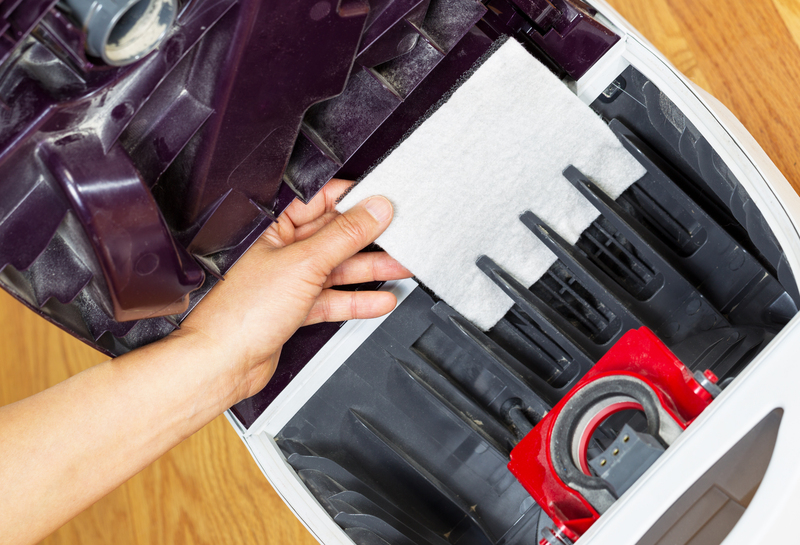Tenants' Handbook: Navigating End of Tenancy House Cleaning
Posted on 20/06/2025
Tenants' Handbook: Navigating End of Tenancy House Cleaning
Moving out of a rented property can be both exciting and stressful. From packing your belongings to arranging logistics, there's a lot to consider! However, end of tenancy house cleaning often ranks as one of the most challenging aspects for tenants. Proper cleaning at the end of your tenancy not only ensures you leave the place in excellent condition, but it's also usually a requirement to get your full deposit back. In this comprehensive guide, we will break down everything you need to know about navigating end of tenancy cleaning, providing actionable tips, checklists, and expert advice to make your moving process smooth, efficient, and hassle-free.
Why Is End of Tenancy Cleaning Important?
The end of your tenancy signals a new beginning, but it also comes with specific responsibilities. Most landlords or letting agents require the property to be returned in the same state it was when your tenancy began, except for reasonable wear and tear.
- Deposit protection: Failure to meet the required cleaning standard can result in deductions from your deposit.
- Lease obligation: Cleaning at the end of a tenancy is a contractual obligation in most rental agreements.
- Smooth property handover: A clean property provides a good impression for the next tenants and maintains a positive relationship with your landlord.
End of tenancy cleaning is not just about tidiness--it's about resetting the property to an almost original condition. Ignoring it may result in disputes, additional cleaning fees, or delays in receiving your deposit.

What Does End of Tenancy Cleaning Involve?
There is often confusion about what constitutes proper end of tenancy cleaning. It is more thorough than regular weekly cleaning, sometimes called "deep cleaning." Let's look at what you can expect:
Typical Areas Covered in an End of Tenancy Clean
- Kitchens: Deep clean of appliances (oven, fridge, freezer, microwave), surfaces, cupboards (inside and out), floors, sinks, and taps.
- Bathrooms: Scrubbing tiles, descaling shower screens, taps, toilet, bath, and sinks, as well as mirrors and extractor fans.
- Bedrooms and Living spaces: Dusting, carpet vacuuming, stain removal, under furniture cleaning, and window washing.
- Floors: All floor types should be vacuumed, swept, or mopped as appropriate.
- Windows: Cleaning the inside window glass, frames, and sills.
- Fixtures and Fittings: Light switches, skirting boards, radiators, doors, and handles should also be wiped down.
- Other Areas: Hallways, staircases, and outdoor spaces if included in your tenancy.
Itemise Your Cleaning Checklist
A comprehensive cleaning checklist is the cornerstone of successful end of tenancy cleaning. Here's a sample checklist to guide you room by room:
- Living Room:
- Dust and wipe all surfaces, furniture, and electronics.
- Vacuum carpets or mop hard flooring.
- Clean skirting boards, light switches, and sockets.
- Clean inside and outside of windows.
- Kitchen:
- Clean oven, hob, and extractor fan.
- Empty and clean fridge and freezer.
- Wipe down all appliances, cupboards, and surfaces.
- Remove limescale from sink and taps.
- Mop the floor.
- Bathroom:
- Scrub toilet, bath, shower, sink, and taps.
- Remove mold and limescale from tiles and grout.
- Clean mirrors and glass surfaces.
- Wipe extractor fan and fixtures.
- Launder bath mats and towels.
- Bedrooms:
- Dust and polish all furniture.
- Clean inside wardrobes and drawers.
- Vacuum or mop floors.
- Wash curtains or wipe down blinds.
- Check for cobwebs in corners and ceilings.
DIY vs. Professional End of Tenancy Cleaning: Which Is Right for You?
When it comes to move out deep cleaning, you have two main options: conduct the cleaning yourself (DIY) or hire a professional cleaning service. Both come with their own set of pros and cons:
DIY End of Tenancy Cleaning
- Pros:
- Cost-effective--saves on service fees
- Greater control over the process
- Can be completed at your own pace
- Cons:
- Time-consuming and physically demanding
- Risk of missing important details
- Some stains or odors may need specialist care
Hiring a Professional End of Tenancy Cleaner
- Pros:
- Thorough and professional results
- Specialist equipment and products
- Offers a cleaning guarantee--helpful for disputes
- Less stress for tenants
- Cons:
- Additional cost
- Scheduling and availability considerations
If your tenancy agreement specifically requires a professional clean, always check if an invoice or proof is needed to satisfy your landlord or letting agent.
Top 10 End of Tenancy Cleaning Tips for Tenants
Whether you're undertaking the cleaning yourself or overseeing a professional service, these essential tips can help you achieve sparkling results and maximize your deposit return:
- Plan ahead: Schedule your end of tenancy cleaning at least a week before your move-out date.
- Declutter first: Get rid of personal belongings, trash, and used items before you start cleaning.
- Take photos: Document the property before and after cleaning for your records.
- Use the inventory: Refer to your check-in inventory to address specific items or areas.
- Address high-traffic areas: Focus on carpets, entryways, and kitchens--these are scrutinized closely!
- Fix small damages: Patch up wall holes, replace lost bulbs, and repair fixtures where possible.
- Avoid harsh chemicals: Use the right cleaning products for each surface to prevent damage (especially wooden floors and countertops).
- Air out the property: Open windows for ventilation and to remove pet or cooking odors.
- Double-check hidden corners: Clean under beds, behind appliances, and inside storage spaces.
- Arrange a final inspection: Walk through the property with your landlord or agent after cleaning.
Common Mistakes to Avoid During End of Tenancy Cleaning
- Ignoring carpets and upholstery: These collect dust, stains, and pet hair. Consider steam cleaning or shampooing if necessary.
- Leaving appliances dirty: Ensure ovens, microwaves, and refrigerators are spotless and odor-free.
- Missing mold or limescale: Particularly common in bathrooms and kitchens, and a frequent cause of landlord complaints.
- Neglecting outside spaces: Balconies, patios, and garden areas should be tidy if included in your lease.
- Forgetting ventilation systems: Dust extractor fans and clean air vents as part of a full property shine.
Even small oversights can result in costly deductions--pay close attention to detail!
How to Choose a Professional End of Tenancy Cleaning Company
If you decide to outsource your move out cleaning, take these steps to choose a reliable, effective service:
- Research reviews and testimonials: Check Google, Trustpilot, or local forums for feedback on cleaning companies.
- Ask about guarantees: Choose a provider who guarantees their work and offers recleans if required.
- Get a detailed quote: Avoid unexpected costs by ensuring the quote covers all rooms and cleaning tasks.
- Check for insurance: Ensure the cleaning company has adequate insurance for accidental damage.
- Review equipment and products used: Ensure they use professional tools and safe cleaning solutions.
A reputable company will be transparent about their pricing, process, and cleaning standards. Ask for a written receipt in case your landlord or letting agent requests proof.
Frequently Asked Questions -- End of Tenancy Cleaning
1. Is professional end of tenancy cleaning mandatory?
Mandatory requirements vary by tenancy agreement. Some landlords or agents insist on a professional clean with proof, while others accept a well-conducted DIY clean. Check your contract carefully.
2. What cleaning products should I use?
Select products suited to each surface. Use gentle, non-abrasive cleaners for delicate materials. Specialist products may be needed for limescale, mold, or tough grime. Always do a patch test first.
3. How long does end of tenancy cleaning take?
This depends on property size and condition. Studios can be completed in a few hours, while larger homes may take a full day or more. Professional teams work faster due to experience and equipment.
4. Do I have to clean the windows outside?
Your lease will clarify this. Most often, tenants must clean inside windows. External window cleaning is usually a building or landlord responsibility, unless explicitly stated otherwise.
5. What if my landlord is not satisfied with the cleaning?
If using a cleaning company, ask for a free reclean guarantee. For DIY cleans, address all landlord comments promptly. Reference your photo evidence and inventory to resolve any disputes.

Final Thoughts: Secure Your Deposit with Outstanding End of Tenancy Cleaning
Moving out can be overwhelming, but with a solid plan and attention to detail, end of tenancy cleaning doesn't have to be a nightmare. Whether you handle it yourself or hire professionals, following a comprehensive checklist and meeting your lease obligations will pave the way for a smooth transition--and help you get your deposit returned in full ?.
Remember, clear communication with your landlord or agent is crucial. If you're ever unsure, ask for clarification in writing to avoid misunderstandings.Ready for Your Move?
As you prepare for your next chapter, use this Tenants' Handbook for End of Tenancy Cleaning to guide your every step. Proactive, detailed cleaning is more than a requirement--it's your key to a fresh start.
- Plan your exit well in advance.
- Check your inventory and lease requirements.
- Choose between DIY and professional cleaning wisely.
- Ensure nothing is overlooked with our checklist.
- Communicate openly with your landlord or agent.
With the right approach, navigating end of tenancy house cleaning is simple, methodical, and stress-free.
Further Resources
- Shelter UK: Cleaning and Repairing the Property
- UK Government: Tenancy Deposit Protection
- Citizens Advice: Getting Your Deposit Back
We hope this guide has given you confidence and expertise in navigating every aspect of your end of tenancy house cleaning experience. Happy moving!




